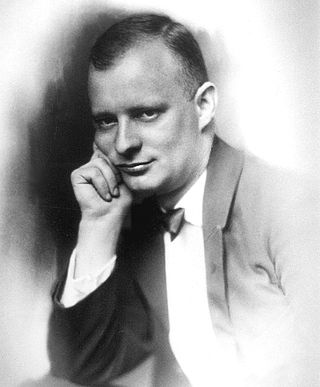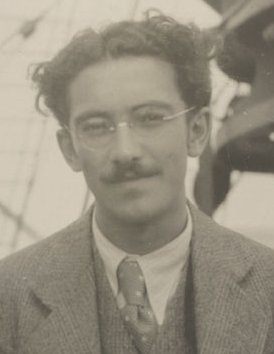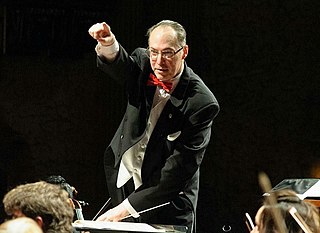
An orchestra is a large instrumental ensemble typical of classical music, which combines instruments from different families. There are typically four main sections of instruments:

Philip Glass is an American composer and pianist. He is widely regarded as one of the most influential composers of the late 20th century. Glass's work has been associated with minimalism, being built up from repetitive phrases and shifting layers. Glass describes himself as a composer of "music with repetitive structures", which he has helped to evolve stylistically.

Paul Hindemith was a German and American composer, music theorist, teacher, violist and conductor. He founded the Amar Quartet in 1921, touring extensively in Europe. As a composer, he became a major advocate of the Neue Sachlichkeit style of music in the 1920s, with compositions such as Kammermusik, including works with viola and viola d'amore as solo instruments in a neo-Bachian spirit. Other notable compositions include his song cycle Das Marienleben (1923), Der Schwanendreher for viola and orchestra (1935), the opera Mathis der Maler (1938), the Symphonic Metamorphosis of Themes by Carl Maria von Weber (1943), and the oratorio When Lilacs Last in the Dooryard Bloom'd (1946), a requiem based on Walt Whitman's poem. Hindemith and his wife emigrated to Switzerland and the United States ahead of World War II, after worsening difficulties with the Nazi German regime. In his later years, he conducted and recorded much of his own music.

Darius Milhaud was a French composer, conductor, and teacher. He was a member of Les Six—also known as The Group of Six—and one of the most prolific composers of the 20th century. His compositions are influenced by jazz and Brazilian music and make extensive use of polytonality. Milhaud is considered one of the key modernist composers. A renowned teacher, he taught many future jazz and classical composers, including Burt Bacharach, Dave Brubeck, Philip Glass, Steve Reich, Karlheinz Stockhausen and Iannis Xenakis among others.

Herbert Thorson Blomstedt is a Swedish conductor.

Leopold Anthony Stokowski was a British-born American conductor. One of the leading conductors of the early and mid-20th century, he is best known for his long association with the Philadelphia Orchestra. He was especially noted for his free-hand conducting style that spurned the traditional baton and for obtaining a characteristically sumptuous sound from the orchestras he directed.

Stuart Oliver Knussen was a British composer of contemporary classical music and conductor. Among the most influential British composers of his generation, his relatively few compositions are "rooted in 20th-century modernism, [but] beholden to no school but his own"

Murray Adaskin, was a Toronto-born Canadian violinist, composer, conductor and teacher. After playing violin with a band, he studied composition and became the director of the Music department of the University of Saskatchewan. Many of his compositions were written while in Victoria after his retirement.

Riccardo Chailly is an Italian conductor. He is currently music director of the Lucerne Festival Orchestra and of La Scala. Prior to this, he held chief conducting positions at the Gewandhausorchester (2005–2016); the Royal Concertgebouw Orchestra (1988–2004); the Berlin Radio Symphony Orchestra (1982–1988); and the Teatro Comunale of Bologna (1986–1993). He was also the first musical director of the Orchestra Sinfonica di Milano Giuseppe Verdi (1999–2005) and principal guest conductor of the London Philharmonic Orchestra (1983–1986).

Viscount Hidemaro Konoye was a Japanese conductor and composer of classical music. He was the younger brother of pre-war Japanese Prime Minister Fumimaro Konoe.

Julius Hegyi was an American conductor and violinist.
James Yannatos was a composer, conductor, violinist and teacher. He was a senior lecturer at Harvard University until his retirement in 2009.
Jesús Arámbarri Gárate was a Spanish classical music conductor and composer native to the Basque Country.
Third stream is a music genre that is a fusion of jazz and classical music. The term was coined in 1957 by composer Gunther Schuller in a lecture at Brandeis University. There are many ways to define third-stream music. It could refer to a group of jazz musicians playing solely, or a jazz soloist performing with a symphony orchestra, as long as the musicians are able to interpret and play jazz music. Improvisation is generally seen as a vital component of third stream. In third-stream music, composers incorporated elements of classical music, such as the use of jazz instruments and classical music forms, into their jazz compositions. The fusion of jazz and classical music is also viewed as "born out of a reciprocal interest: the interest of the classical community in the developments in jazz music and the interest of the jazz community in the advances of classical music." The innovative idea of fusing jazz and classical music pushed the boundaries of traditional classical music and introduced a new genre that blends the two styles into a unique hybrid form.

Kevin R. McMahon is an American, orchestra/opera conductor, composer/orchestrator/arranger, clinician/adjudicator, and violinist.
Emanuel Leplin was a composer, conductor, and painter active mainly in the second half of the 20th century. He was born in San Francisco, and joined the San Francisco Symphony as a violist in 1941, conducting it in two of his own works, in 1941 and 1947. In 1954, he contracted polio, and afterward, was unable to hold a brush or compose using anything below his neck but the first three fingers of his right hand. With these fingers he composed three symphonies, a violin concerto, and many other works for orchestra and chamber groups.

Benjamín Gutiérrez is a celebrated composer in Costa Rica. He is a conductor, composer, and pianist. Gutiérrez began by studying music with his grandmother, Rosa Jiménez Nuñez, daughter of the composer Pilar Jiménez.” Gutiérrez then studied music in Guatemala City, Boston, Ann Arbor, Aspen, and Buenos Aires. The following were among his teachers: Ross Lee Finney, Darius Milhaud, and Alberto Ginastera. Gutiérrez has written music for piano, orchestra, violin, viola, clarinet, flute, saxophone, trombone quartet, bassoon quartet, marimba, opera, and several other instruments.
Rudolf Hindemith, since 1951 officially Paul Quest, pseudonym Hans Lofer was a German cellist, composer and conductor. He was solo cellist of the Vienna State Opera, and played chamber music in the Amar Quartet. He stood often in the shadow of his famous brother Paul but was rediscovered in recent years as a composer of an opera, a piano concerto, chamber music and piano pieces.
The Short Symphony, or Symphony No. 2, is a symphony written by the American composer Aaron Copland from 1931 to 1933. The name derives from the symphony's short length of only 15 minutes. The work is dedicated to Copland's friend, the Mexican composer and conductor Carlos Chávez. The symphony's first movement is in sonata-allegro form, and its slow second movement follows an adapted ternary form. The third movement resembles the sonata-allegro but has indications of cyclic form. The composition contains complex rhythms and polyharmonies, and it incorporates the composer's emerging interest in serialism as well as influences from Mexican music and German cinema. The symphony includes scoring for a heckelphone and a piano while omitting trombones and a percussion section. Copland later arranged the symphony as a sextet.
Daniel Troen Moe was an American choral conductor, composer, and pedagogue. He was director of choral organizations for the University of Iowa, professor of choral conducting at Oberlin College Conservatory of Music, and founding music director of Key Chorale in Sarasota, Florida. He was a published composer and author. He was once hailed by The New Yorker music critic Andrew Porter as "that dean of choral conductors."













